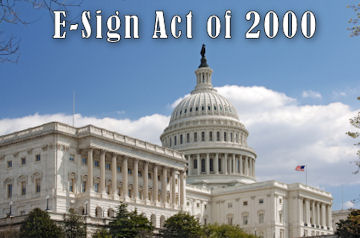- Published on
eSign Act is 17 years old, what’s the state of electronic signature
- Authors
-
-
- Name
- Shamsh Hadi
-

Electronic Signature was invented in 1995. It only took 5 years and in 2000 eSign Act was signed by President Bill Clinton. This was the turning point for the business process automation, business process optimization, and digital transformation of workplace and business movements. It was the same time when people didn’t yet feel comfortable giving their credit card information online. The mainstream business leaders knew little about what to do with this eSign Act and how it will impact the business world. Today eSign Act is 17 years old, what’s the state of electronic signature
The main intention of the eSign Act was to validate and legitimise business transactions that occurred over the internet, save the parties from fraudulent behaviour, and ultimately replace pen and paper signatures or “wet” signatures. When it comes to understanding whether your eSigned document is legally binding, the definitions provided both by UETA and the US eSign Act are both amply clear, provided you have a trustworthy provider. Implicit and explicit promises made by the eSign Act included:
- Reduce and eventually eliminate use of paper from every business transaction that required signatures or acknowledgement of any sort (Save trees)
- Automate and optimize business processes
- Make business transactions secure, fraud-resistant, legal, and error-free.
- Save time and money (shipping and handling, copying, physical storage, etc.)
Where are we today?
Unfortunately, we have barely scratched the surface when it comes to adoption of electronic signatures. Rightfully so, it took us over a 100 years to figure out the pen-and-paper process. We had to work through different cultures, business practices, languages, countries, education level, and more. The good news is that we have a much better idea of what it will take for electronic signatures to become mainstream. Here is our take on where we are today:
- There is limited adoption company-wide. It’s less of a company-wide initiative and more a prerogative of a particular department. HR and procurement is easy sell, legal, not so much.
- Our POS systems are capturing electronic signatures but companies are not authenticating, verifying and processing them in the back end. Since credit card companies insure fraudulent purchases, merchants don’t feel the need to invest in this particular area.
- Most electronic signature solutions are images of signatures coupled with security wrappers around them.
- We haven’t quite figured out the security aspect of the signatures and the eSignature vendors who house these documents and valuable customer information.
- Only a small percentage of world’s businesses have adopted eSignature at some level.
- Masses or mainstream is educated at a very rudimentary level.
- There is a resistance to changing years of business processes due to old habits, lack of full confidence in the solution, comfort level, legality and more.
- A handful of vendors have developed great basic solutions and out-of-the-box integrations.
- Majority of the companies shy away from adopting this solution because of huge underlying cost and time required to implement the solution.
Trends in Electronic Signature over the next few years
If we continue to make progress at this pace, over the next few years we anticipate work in the following seven areas:
- Security and assurance
- Post-execution fraud protection
- Acceptance in court
- User experience and ease of use
- Pre-packaged integrations
- Blockchain implementation
- Biometrics and mobile biometrics